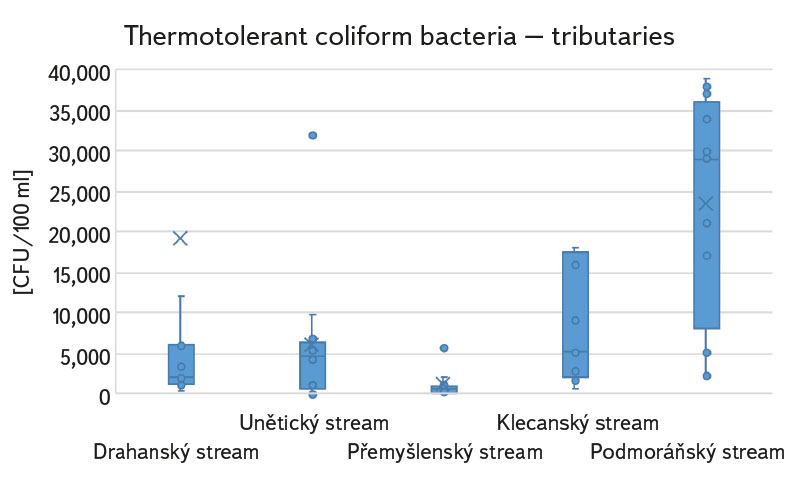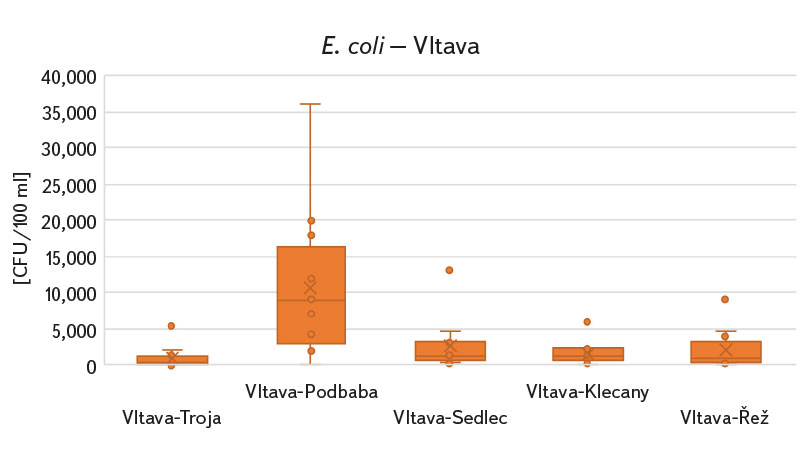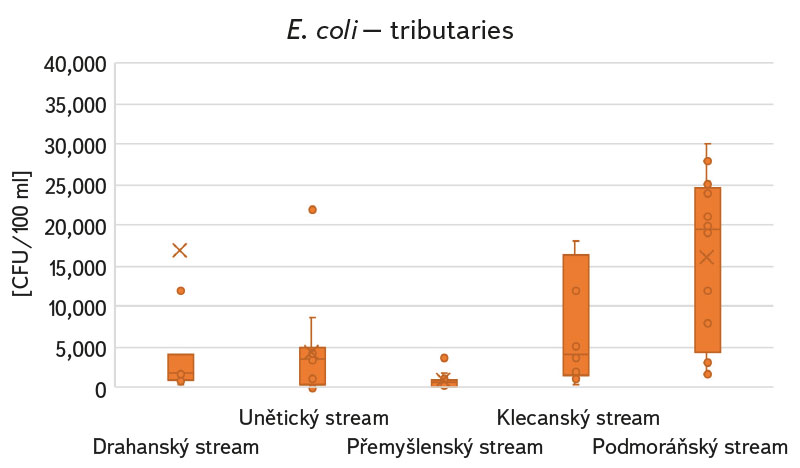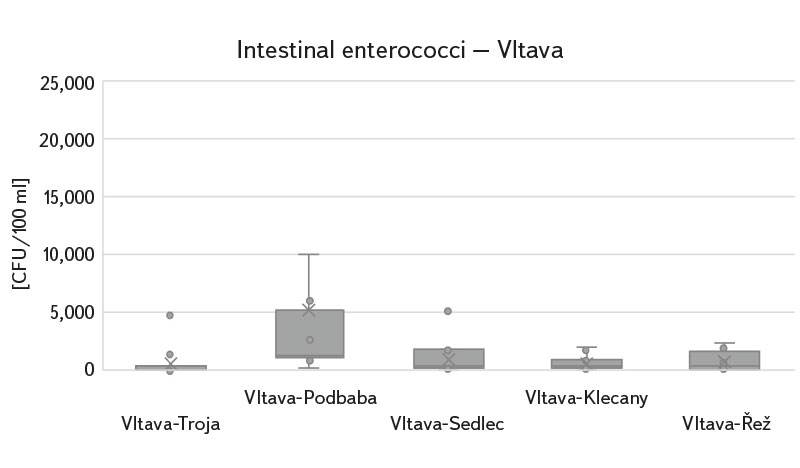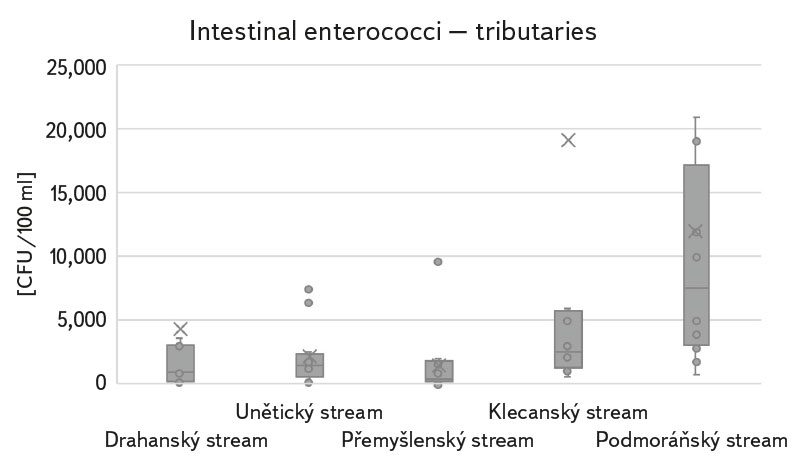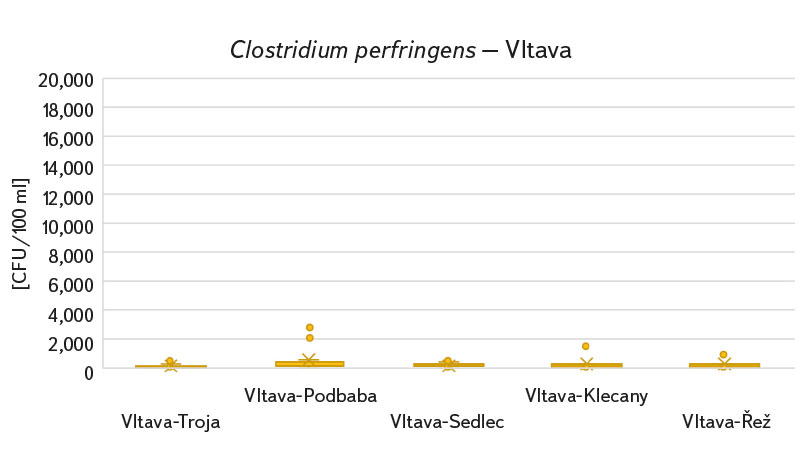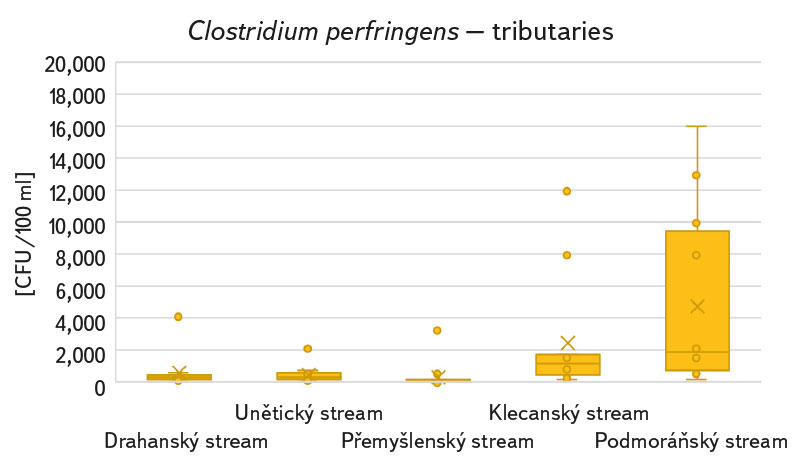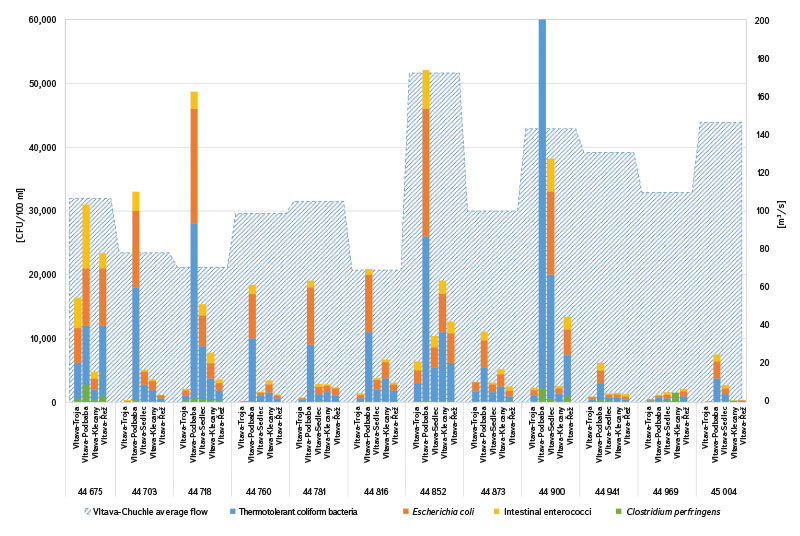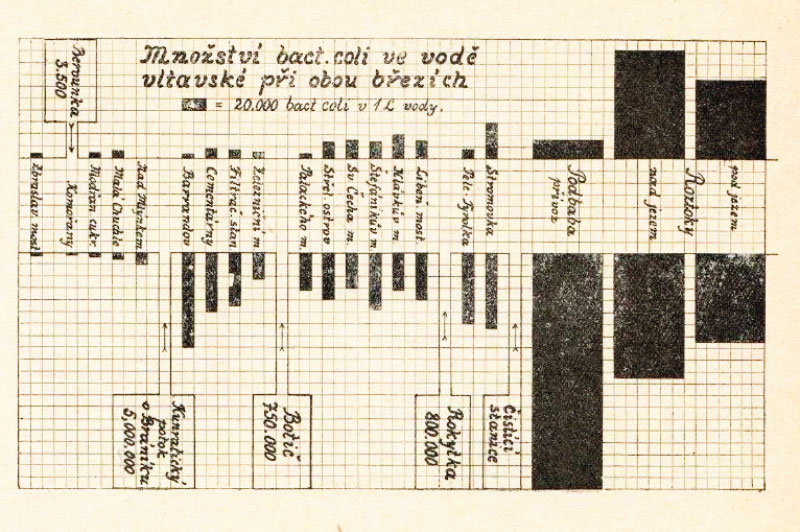ABSTRACT
In terms of public health protection, the most important indicator in surface water monitoring is microbial fecal contamination. Despite the introduction of the best available technologies, their biggest source is treated and untreated municipal wastewater. Around 90 % of the Czech population use their local sewerage system, which is linked to a WWTP, treated, and discharged into recipient waters. Monitoring of microbial contamination of the Vltava below Prague CWWTP showed a level of fecal pollution in the 10 km section below the wastewater inflow in periods with different flow rates. Smaller tributaries of the Vltava, which bring treated wastewater from local WWTPs to the Vltava, were monitored as additional sources. From April 2022 to March 2023, the amount of Escherichia coli, enterococci, thermotolerant coliform bacteria, and Clostridium perfringens were monitored at ten sampling sites. The monitoring results showed relatively significant microbial pollution of the Vltava from Prague CWWTP discharge and, at the same time, the river’s substantial self-cleaning ability in the following section. This creates good potential for the river’s future utilization in the monitored area, with the exception of the section directly affected by the inflow of treated wastewater from Prague CWWTP. This study could be used to raise public awareness in order to minimize the health risk caused by the river’s inappropriate utilization (possible presence of pathogenic microorganisms, including carriers of antimicrobial resistance).
INTRODUCTION
The Vltava is an important watercourse which, along its entire length, is the recipient of the inflow of a large volume of wastewater. Thanks to its high water bearing and cascades of water reservoirs, it can eliminate the pollution brought into it relatively effectively. The largest load on the Vltava comes from the capital city of Prague, not only from the Central Waste Water Treatment Plant (CWWTP), but also other smaller treatment plants. Municipal wastewater is one of the main sources of contamination of surface streams with microbial contamination, despite the obligation to use the best available wastewater treatment technologies at WWTPs. Some microorganisms significant for hygiene are not completely eliminated by treatment processes, and thus subsequently adversely affect the quality of water in watercourses, where they can represent an acute (viable microorganisms) or passive (e.g., spread of antibiotic resistance) health risk and a reduction in water usability, such as for recreation and irrigation. Despite this fact, the mechanisms for controlling microbial pollution of wastewater from WWTPs are not currently determined by legislation. In addition, the risk has increased with the current climate period, with the occurrence of extreme phenomena (drought and torrential rainfall). Both of these phenomena are critical for maintaining good microbial quality of surface waters. In periods of low flow rates, due to the low dilution of wastewater from WWTPs and other municipal sources, there is an increased concentration of microbial contamination in streams. In cities, torrential rain poses the risk of increased loading of streams by flood-ways, which bring untreated wastewater that the WWTPs are not able to manage. These facts have significantly contributed to the increased microbial load of watercourses in the long term [1, 2, 14]. Water quality in the Vltava is regularly monitored by the watercourse manager within the state surface water quality monitoring network for the ISVS (Informační systém veřejné správy, Public administration information system) – surface water quality records of the CHMI (Czech Hydrometeorological Institute). However, the sparse network of sampling sites (Vltava above Prague-Vrané nad Vltavou; Vltava below Prague-Zelčín) and the limited scope of monitoring cannot capture the risks associated with microbial contamination of the watercourse.
In our study, the Vltava in Prague and below the city was chosen for the purpose of a closer understanding of microbial contamination and its natural elimination in a large watercourse. Fecal pollution of the water in a recipient watercourse was assessed by determining standard indicator groups of microorganisms Escherichia coli (E. coli), thermotolerant (fecal) coliform bacteria, intestinal enterococci, and Clostridium perfringens, whose spores are highly resistant to external environmental factors and survive in wastewater and surface water for a long time [3, 4].
The aim of the study was to characterize microbial pollution in the longitudinal profile of the Vltava below Prague and to determine the degree of increase in health risk and decrease in the usability of water burdened by fecal pollution due to the inflow of wastewater from the WWTP in the monitored section, and to assess the development trend in comparison with historical data [5].
METHODOLOGY
A 10 km section of the Vltava (from Troja to the Vltava-Řež sampling site) was monitored to determine the influence of treated wastewater discharge from the WWTP on water quality in the researched section of the river’s longitudinal profile (Fig. 1–3). The descriptions and locations of the sampling sites are shown in Tab. 1 and Fig. 4. Sampling sites on the Vltava were selected for monitoring where it is possible to assess the impact on its water quality by the inflow of treated wastewater from the Prague CWWTP and smaller WWTPs on the tributaries. The characteristics of these WWTPs are shown in Tab. 2. For technical reasons, the sampling sites capturing pollution input from the Prague-Bohnice, Nebušice, and Roztoky WWTPs were not included in the monitoring. Other tributaries in the monitored area have no WWTP inflow.
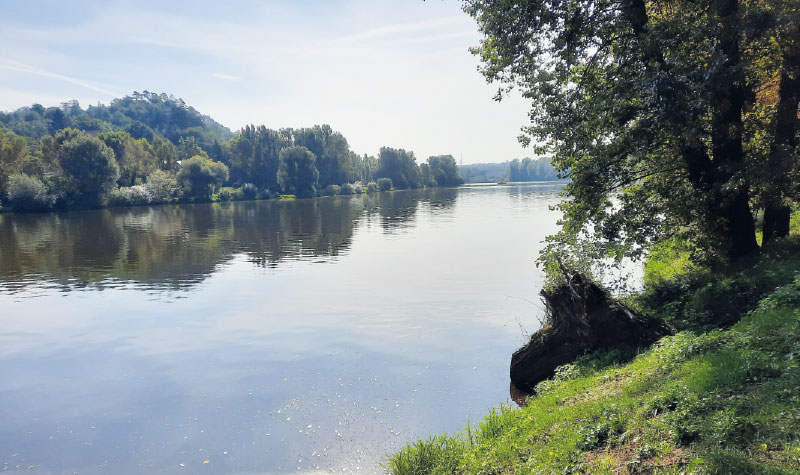
Fig. 1. Vltava in Podbaba below the wastewater inflow from the current and new water line of CWWTP Prague
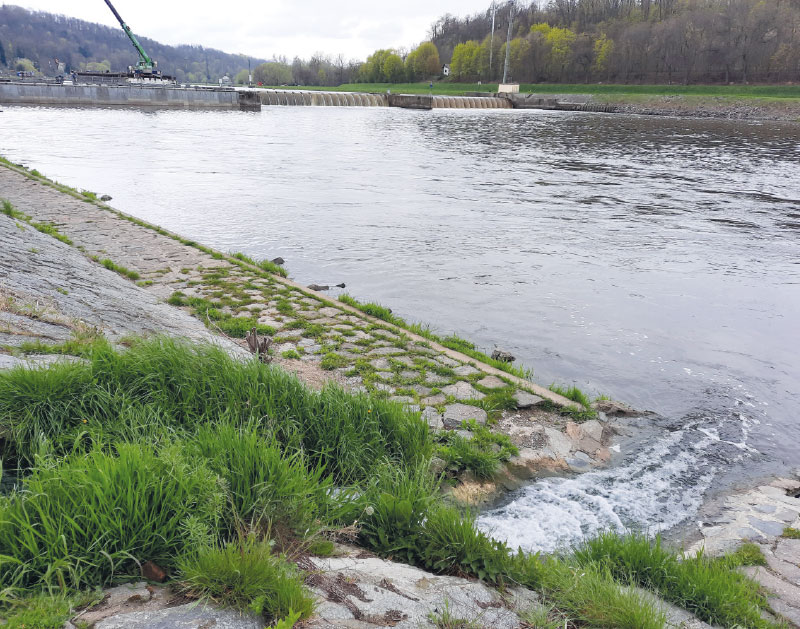
Fig. 2. Inflow of the Klecanský stream into the Vltava in Klecánky
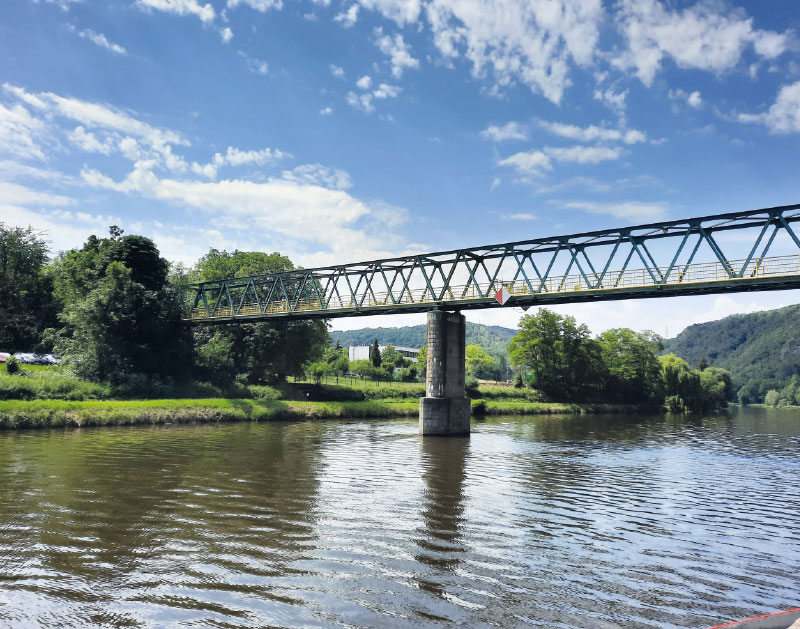
Fig. 3. Vltava in Řež (the last sampling site of the monitored section)
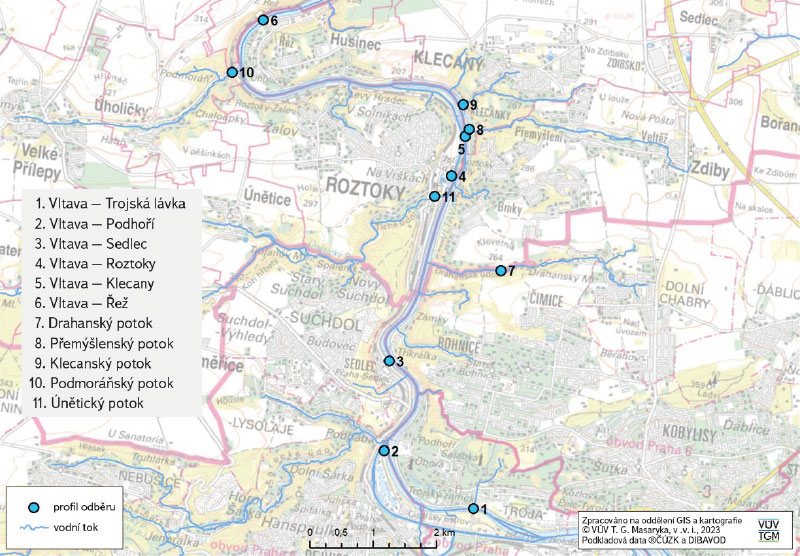
Fig. 4. Sampling sites locations
Tab. 1. Description and location of sampling sites
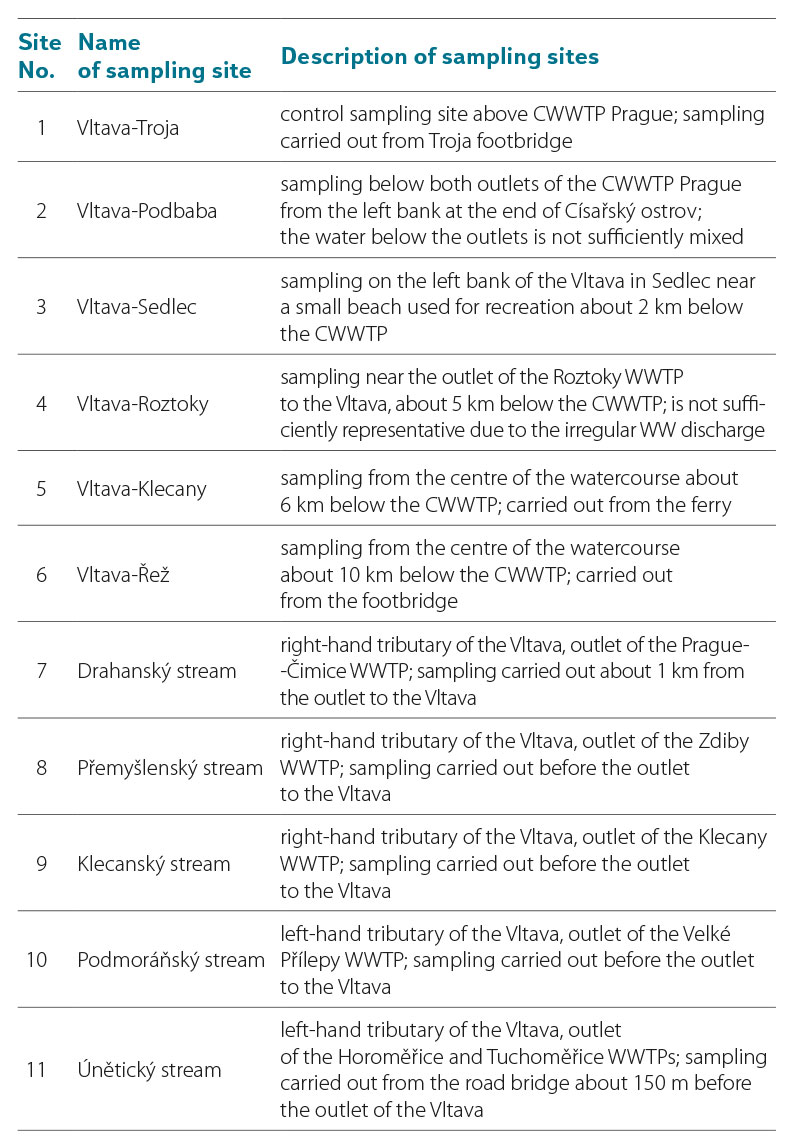
Tab. 2. Basic WWTP characteristics
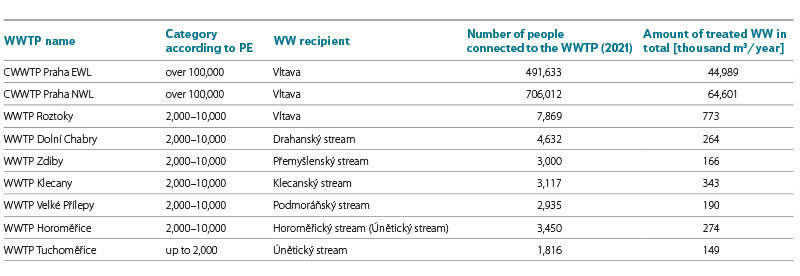
The amount of E. coli, intestinal enterococci, thermotolerant (fecal) coliform bacteria, and Clostridia perfringens were determined by standard culture methods. Determination of thermotolerant (fecal) coliform bacteria and E. coli was carried out according to ČSN 75 7835 standard, intestinal enterococci according to ČSN EN ISO 7899-2 standard, and Clostridia perfringens according to Decree 252/2004 Coll., Annex 6. For culture determination, methods according to the following procedures were used [6–8]. Plain samples were taken from April 2022 to March 2023 with a monthly frequency at the above-mentioned sampling sites.
The results were classified into quality categories according to ČSN 75 7221 [8] and compared with EQS limits (environmental quality standards) for surface waters according to Government Regulation No. 401/2015 Coll. [10]. For information, the results were compared with the limits for bathing waters according to Decree No. 238/2011 Coll. [11].
ČSN 75 7221 [8] uses the characteristic value C90 and, based on it, classifies flowing surface water into five classes according to quality (Tab. 3). The standard allows the so-called purposeful classification according to its own range of indicators, when the resulting class is determined according to the most unfavourable classification. In our case, the classification was used for indicators of thermotolerant (fecal) coliform bacteria and intestinal enterococci.
Government Regulation No. 401/2015 Coll., on indicators and values of permissible pollution of surface waters and wastewater, requirements for permits for discharge of wastewater into surface waters and into sewers, and on sensitive areas from 2016 [10] specifies EQS values for microbiological indicators as P90 for E. coli, intestinal enterococci, and thermotolerant (fecal) coliform bacteria (Tab. 3).
Decree No. 238/2011 Coll., on the establishment of hygiene requirements for swimming pools, saunas, and hygiene limits of sand in sandpits of outdoor playgrounds from 2011 [11] differentiates between intestinal enterococci and E. coli indicators based on P90 and P95 into three quality levels (Tab. 3).
Tab. 3. Classification of microbial parameters
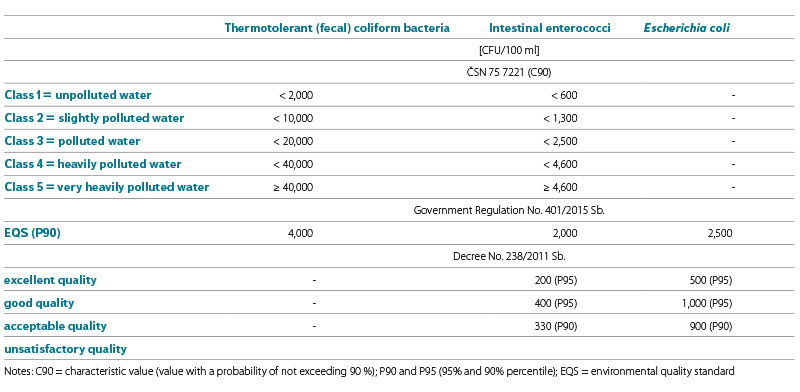
RESULT
The results of microbial pollution monitoring from April 2022 to March 2023 are shown in the graphs in Fig. 6–15.
The assessment according to ČSN 75 7221 (Fig. 5) showed the best quality at the Vltava-Troja control sampling site, which was classified as slightly polluted water (quality class 2). The outlet of treated wastewater from the CWWTP changed the water quality in Vltava-Podbaba to quality class 5 (very heavily polluted water). Thanks to the intensive dilution of microbial pollution and the active watercourse self-cleaning, the water in the other monitored locations of the longitudinal profile of the Vltava already corresponded to quality class 3 (polluted water). The discharge from heavily polluted tributaries (i.e., Drahanský, Klecanský, Podmoráňský, and Únětický streams) did not contribute to the significant deterioration of water microbial quality. Of the monitored streams, Přemyšlenský stream showed the best quality, on which the apparently well-functioning WWTP from the village of Zdiby-Přemyšlení is located.
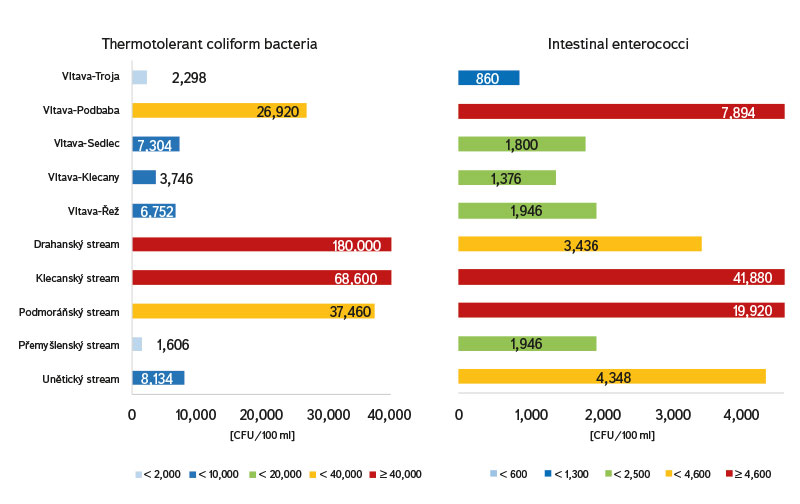
Fig. 5. Sampling site pollution rates for thermotolerant (fecal) coliform bacteria and intestinal enterococci according to Czech technical norm ČSN 75 7221
The water quality at the monitored sampling sites was compared with EQS for microbiological indicators, expressing the surface water status (Tab. 3). The results for all monitored indicators are presented in Figs. 6–13 and in Tab. 4. Both the graphs and the table show significant differences between the individual sampling sites, not only in the Vltava but also in its tributaries below Prague. Indicators of thermotolerant (fecal) coliform bacteria and E. coli were exceeded at 60 % of the sampling sites in the Vltava and in 80 % of the tributaries; the indicator of intestinal enterococci was exceeded at only 20 % of the sampling sites in the Vltava, but in 80 % of the tributaries. The control sampling sites on the Vltava above the CWWTP and the Vltava-Klecany met the requirements of Government Regulation No. 401/2015 Coll. for all three indicators. Despite the inflow of pollution from many sources during its flow through Prague (including the significantly polluted Botič and Rokytka streams), the results showed that the Vltava in Troja has unexpectedly good water quality. According to the original assumptions, a significant increase in the number of microbial indicators occurs in the next section, where wastewater treated on two water lines of the Prague CWWTP flow into it. This is despite the fact that the CWWTP is equipped with modern treatment technology that meets the requirements for the best available wastewater treatment technologies and is actively taking other steps to improve the quality of discharged water, such as UV disinfection of treated wastewater (which was put into trial operation in October 2021). As the graphs in Fig. 6–14 show, intensive dilution and self-cleaning occur in the Vltava, thanks to which there are already significantly fewer microbiological indicators in the section from Sedlec, namely about 2 km below the CWWTP.
Surprising differences were found in the microbial quality of the water of the Vltava tributaries below Prague into which wastewater from local WWTP is fed (Fig. 6–14, Tab. 4). Critical pollution was brought by the Klecanský and Podmoráňský streams, to which the Klecany and Velké Přílepy WWTPs are connected, i.e., around 6,000 connected inhabitants. In contrast, Přemyšlenský stream (Zdiby WWTP; 3,000 connected inhabitants) showed the lowest pollution throughout the monitoring period. Thanks to the relatively low water bearing of the polluted tributaries, the influence on the Vltava below their inflow is not significant (Fig. 14). According to ČSN 75 7143, Vltava water is “conditionally suitable” for irrigation at most sampling sites, i.e., the numbers of thermotolerant (fecal) coliform bacteria and enterococci range between 1,000 and 10,000 CFU/100 ml [15].
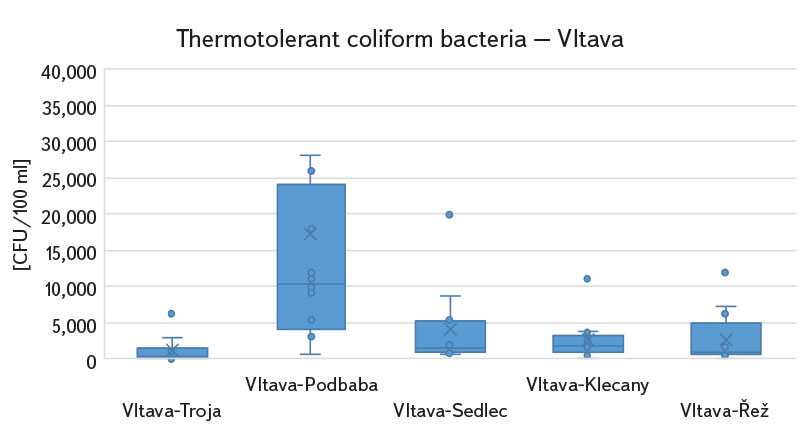
Fig. 6–13. Microbial water quality of monitored sites of the Vltava and its tributaries
Tab. 4. Classification of microbiological parameters
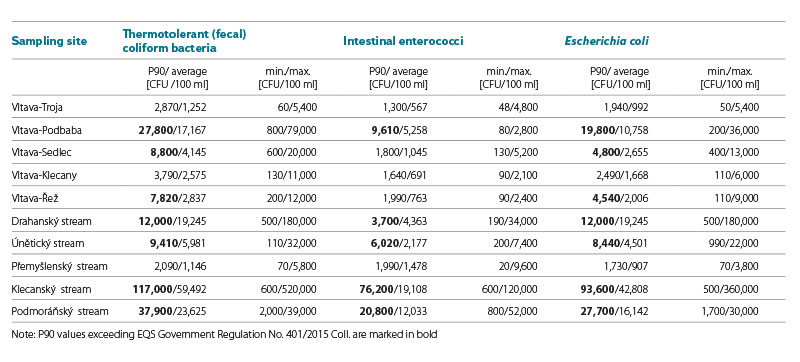
The results were further evaluated according to Decree No. 238/2011 Coll., which assesses water quality after the end of the bathing seasons (ideally 4) based on its determination according to the indicators listed in Tab. 3. Water is classified as “unsuitable” for bathing if the values of any of the indicators are higher than the values for “acceptable” quality. According to the above assessment, in the observed period, none of the Vltava’s sampling sites achieved a quality acceptable for bathing. However, at the Vltava-Troja sampling site, in the period suitable for recreation (i.e., from May to September), the numbers of CFU in both indicators were found to be 100 % corresponding to the limits for “acceptable” quality. The sampling site is located near Troja slalom channel, where canoeists often come into contact with water. In the next section of the watercourse, below the inflow of the CWWTP, values below the limit for unacceptable quality appeared only sporadically. The situation was better with intestinal enterococci. At the Vltava-Řež sampling site, about 10 km from the CWWTP, in the period suitable for recreation (May to September), the numbers of CFU in both indicators were found to be already 70 % corresponding to the limits for “acceptable” quality. Some sampling was carried out after heavy rain, which negatively affected the water quality (Fig. 15).
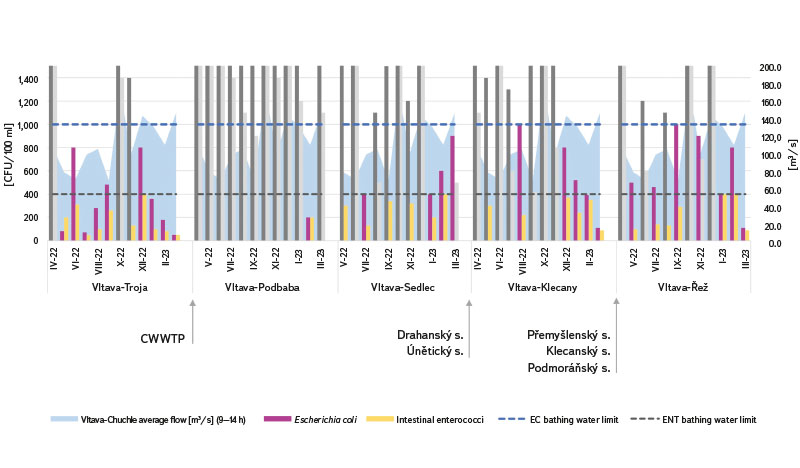
Fig. 14. Seasonal progress of selected microbial indicators in the Vltava; columns with values exceeding the bathing water limits are represented in grey – dark grey for E. coli, light grey for enterococci
Fig. 15. Sum of selected microbial indicators during the monitoring in comparison with Vltava flow rate
DISCUSSION
The aim of this study was to monitor the current state of water quality in the Vltava from Troja to the footbridge in Řež, along with several important tributaries with an inflow from local WWTPs. Water quality in this part of the Vltava is not systematically monitored and suggests very strong pollution, both from the many sources below Prague and from the discharge of treated wastewater from the Prague CWWTP on Císařský ostrov. Annual monitoring of this area was aimed at identifying limitations in the usability of the Vltava water for its further use (e.g., recreation and irrigation). The results showed that the Vltava has huge capacity to absorb pollution and eliminate it. However, the use of water for recreation is completely limited in a relatively short section below the CWWTP inflow. After a few kilometres, however, the watercourse regenerates from the point of view of microbial contamination, probably due to strong dilution, sedimentation, and active self-cleaning processes. Although the study was not focused on monitoring changes due to climatic episodes, it was found that both extreme conditions (drought with low flows and heavy torrential rains) have a negative effect on water quality. Low flows will limit the possibility of diluting the incoming pollution, which was already visible at the control Troja sampling site; on the other hand, torrential rain worsens water quality in the Vltava and its tributaries due to the effect of surface pollution flushes and the inflow of flood-ways directly into the recipient watercourses.
The microbial quality of the water in the Vltava below Prague has not been systematically monitored in recent years or the data has not been published. The sampling sites monitored as part of the surface water monitoring programme are relatively less dense in the section of the Vltava below Prague due to the larger size of the water bodies. The Vltava is regularly monitored at the representative sampling sites of Vrané nad Vltavou and Zelčín. In Prague, water quality is monitored in detail at the Vltava-Podolí sampling site, and basic physico-chemical and microbiological indicators are monitored at the Prague-Troja sampling site. Pražské vodárny a kanalizace, a. s. also monitors the Prague-Podolí sampling site.
The first, completely unique bacteriological study of the Vltava was carried out in 1931 by Kredba and Dvořák [5, 12]. In this study, a one-time monitoring of the presence of microorganisms was performed. Sampling was done in a short time interval (3 days) in April to be as little affected by climatic and other factors as possible. Samples were taken from both banks in the marked section, which started above Prague at the Zbraslav bridge and ended below Prague under the weir in Roztoky. Sampling sites were chosen so that each source of pollution could be captured. In accordance with the methods of the time, “bact. coli numbers in 1 l” (modified Ficker-Partiš method on Endo agar) and “number of germs in 1 ml” were determined. We assume that the method of determining bact. coli could be comparable to today’s method of determining coliform bacteria on Endo agar [4]. A comparison of historical and current data is shown in Tab. 5.
Tab. 5. Comparison of present fecal pollution situation with historical data
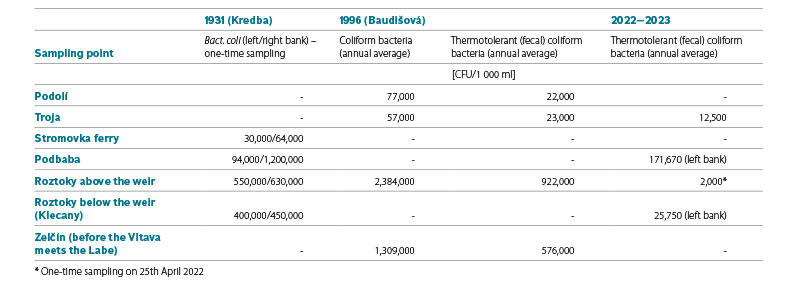
Another source of older data was the study by Baudišová [13, 14] in 1997, which dealt with the water microbial quality in the Labe and the lower Vltava. The study was focused on the quality of the water before the Vltava meets the Labe, and coliform bacteria and thermotolerant (fecal) coliform bacteria were monitored in it. The values found at the Podolí, Troja, Roztoky and Zelčín sampling sites are shown in Tab. 5. A comparison of the values of coliform bacteria in 1 l of water from the three periods indicated a significant decrease in microbial contamination since 1931 at the Podbaba and Roztoky sampling sites. In all three periods, an increase in microbial contamination below the CWWTP inflow is evident, while the current state is the most favourable thanks to advanced treatment technologies.
Fig. 16. Amount of bact. coli in the Vltava river in 1931
CONCLUSIONS
The updating of historical data describing microbial contamination of water in the Vltava below Prague showed a favourable trend in development, which is a consequence of improving technological processes of wastewater treatment.
It was found that fecal contamination at the Vltava-Troja control sampling site is unexpectedly low, despite the fact that it receives pollution from many sources in Prague. In the period when it could be used for recreation, the water showed “acceptable” quality according to Decree No. 238/2011 Coll.
Water quality at the other sampling sites was strongly affected by discharged purified wastewater from both CWWTP water lines, and in the area near the sampling site, its further usability was strongly reduced, especially for recreation.
However, the condition quickly improved in the next section of the Vltava thanks to dilution, sedimentation, and cleaning processes; the water quality at more distant sampling sites already showed “acceptable quality” during some samplings during the period of possible summer recreation.
Although the study was not focused on monitoring changes due to climatic episodes, it was found that both extreme conditions (drought with low flows and heavy torrential rains) have a negative effect on water quality. Low flows will limit the possibility of diluting the incoming pollution, which was already visible at the Troja control sampling site; on the other hand, torrential rain worsens water quality in the Vltava and its tributaries due to the effect of surface pollution flushes and the inflow of flood-ways directly into the recipient watercourses.
The study showed relatively good potential for the possible use of the Vltava in Prague and below Prague, with the exception of the section strongly affected by the inflow of treated wastewater from the Prague CWWTP. In general, it would be advisable to focus on increasing awareness with a help of this and similar studies, so that water can be used more efficiently and, conversely, so that it does not represent a significant health risk when used inappropriately (possible presence of pathogenic microorganisms, including antibiotic resistance carriers).
With regard to the growing requirements for the protection of the health of the human population and improvement of water quality in streams to the level of the standards of European directives, it is necessary to focus more attention on the monitoring microbiological indicators of water quality than is ensured by the current routine monitoring system.
Acknowledgements
The article was written with the support of the Institutional funds for the development of the TGM WRI research organization within the internal grant No. 3600.52.24/2022 and the project SS02030008 “Centre of Environmental Research: Waste management, circular economy and environmental security” (CEVOOH).
The Czech version of this article was peer-reviewed, the English version was translated from the Czech original by Environmental Translation Ltd.
